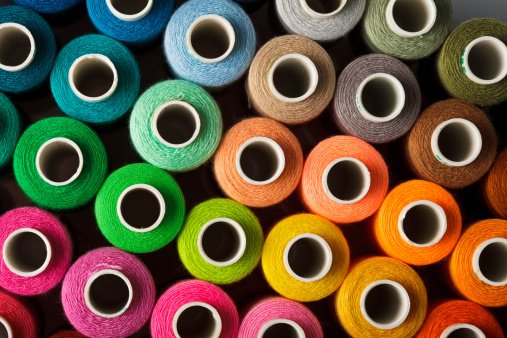Sewing Machine Thread – Top 12 Tips to Avoid Breaking
Sewing machine thread not only does it useful but also closes and stitches seams. This top 12 tips to avoid breaking sewing machine thread will guide you on the most relevant tips to use the correct thread.
There are a few things more frustrating than having your sewing machine thread break in the middle of a project.
To avoid this, it’s important to know how to properly care for and use your sewing machine thread.
In this article, we’ll share 12 tips to help you avoid breaking your sewing machine thread. By following these tips, you’ll be able to sew for longer periods of time without having to stop and replace your thread.
What Is Sewing Thread All About?
Sewing thread is a trim that secures seams and ensures the functioning features of a garment or other textile product. It is a unique kind of yarn that can only be used for sewing; it cannot be used for knitting or weaving.
By hardly or barely twisting, it can be produced of staple fiber or continuous filaments. Threads are created by twisting together two or more filament strands.
Single filaments are also employed occasionally. Sewing threads can be produced using natural, synthetic, or mixed fibers.
When it comes to closing and top stitch seams, core spun threads are ideal because they can produce seams of exceptional quality.
Continuous bulk filament threads are ideal for cover stitch or overlock seams. Natural and synthetic fiber blended core spun threads are ideal for sealing seams on high-quality denim clothing. Continuous filament threads are ideal for generating ideal seam strength for leather items.
Top 12 Tips to Avoid Breaking your Sewing Machine Thread
Sewing is a delicate process that requires great care and attention to detail. The following tips explain practical ways on how to avoid your sewing machine thread being damaged or broken:
Tip #1: Use Bobbin Thread
Your bobbin thread may also be a source of thread breaks. Some lower-quality bobbin thread will either leave lint, fluff, or adhesive residue, which might affect how well the machine works.
The bobbin’s casing and surroundings should be examined because they could be the cause of the thread becoming trapped, knotted, or running incorrectly.
Therefore, we always strongly advise using a bobbin that hasn’t had glue or other residue applied to it. Remainder-coated threads have a slightly sticky feel to them. As an illustration, glue is used to keep side-less bobbins together.
When winding the bobbin by hand, take care not to overwind it. With finer bobbin threads, this can happen simply since the machine’s self-stopping mechanism doesn’t always immediately recognize the finer thread.
To prevent this when winding your own bobbin, we suggest stopping just before the bobbin’s edge.
To attain better tension results, we usually advise using a finer bobbin thread, such as DecoBob 80wt. Because the bottom thread is thinner, it will make the fabric appear lighter and always give way to the top thread, preventing a tug-of-war over machine tension.
Tip #2: Avoid Tension on your Sewing Machine Thread
Whenever stitching, this is a crucial consideration. If the tension is excessively tight at the top or bottom, the thread may break. Before beginning your project, we usually advise sewing a test strip on a piece of fabric to check the quality of your tension.
The top tension is excessively tight and needs to be reduced if you notice the bobbin thread pulling through to the top.
The bobbin tension is too tight, and it needs to be relaxed, if you notice the top thread pulling through to the bottom thread. Every machine is unique, as are elements like the fabric you’re using, the batting, and stabilizer, along with the kind and weight of the thread you’re using.
Because there are so many factors to take into account, it’s advisable to always stitch a test piece and change your tension as necessary.
Tip #3: Use Stack- or Cross-Wound Thread
If you’ve ever looked closely at your thread spools, you might have noticed that the thread is coiled onto the spool in two different ways. Stack wound thread is defined as thread that has been wound on the spool in a uniform, straight pattern. The most prevalent type of cross-wound thread will be wound at an angle.
Your thread will need to draw off the side of the spool if you are stitching with a stack wound spool. You may do this quickly by setting it on your sewing machine’s vertical spool pin. Draw the thread from the top of the spool if you are sewing with a cross-wound spool.
You can achieve this by setting it on the machine’s horizontal spool pin. The thread will drag over the spool if the spool is placed on the incorrect pin, leading to tension issues and maybe thread breakage.
Tip #4: Accessorize
It’s best to think about how various sewing accessories can improve your sewing experience if you’re using a speciality thread. We strongly advise using a Wonder GuardTM if you frequently find that your spool’s base collects slippery thread.
This thread guard should be wrapped around the spool to prevent the slick thread from sliding around the base of the cone, where it could become trapped, twisted, modify the tension of the thread, and result in thread breaks.
Tip#5. Consider the Size and Type of Needles.
Checking your machine needles is often a normal step that should never be skipped. Frequently, using the wrong needle will result in a thread break issue. Make sure your needle is the appropriate size for the project’s thread before you begin stitching.
The smaller the number on the packaging, in both American and European sizes, the smaller the needle. The same holds true for bigger groups.
Larger needles are made for heavier threads like 12wt, while smaller needles work well for thinner threads like 80wt. For reference, a needle size of 80/12 is frequently used for medium thread such as 40wt or 50wt.
Additionally, be certain that the cloth you are sewing with is suitable for the sort of needle you are using. For instance, while stitching thick denim cloth, you would use a denim needle.
Or a jersey needle with a ballpoint. Every type of needle has a certain function, so make sure to find out what you need to get the best results!
It’s wise to keep in mind the significance of choosing the right needle because its size and kind will significantly affect how well your project turns out.
It’s possible that using the wrong needle could result in skipped stitches and tension problems, which will also cause thread breaks.
Tip #6. Examine the Tension of the Top Thread.
The hook might strike the thread rather than grab it if there is too much tension on the needle, which could happen. The thread may flatten down in the tension discs or knot up before the discs as a result of excessive stress.
Tip #7. Check the Balance of the Strain.
Bottom tension should be as loose as feasible if top tension needs to be tight. Only use enough tension to produce a pleasing seam.
Tip #8. Make Sure the Throat Plate Opening is not Overly Big.
A hole that is too big will allow material to follow the needle under the throat plate, causing issues with feeding and loop formation.
Tip #9. Inspect the Needle bar for Excessive Play.
This could indicate that the needle moved while you were adjusting the timing.
If you follow the above instructions, your problems with shredding or thread separation will be a thing of the past. Please get in touch with us to find out more.
Tip #10. Wash and Lubricate the Apparatus.
Sometimes all that is necessary to get the machine back in working order is this straightforward procedure.
Tip #11. Verify the Timing
To make sure the hook or looper is crossing at the proper time and distance from the needle you have to Verify the timing for the specific setting needed, and then consult the machine’s manual.
Tip #12. Inspect
In order to avoid cutting the thread, inspect the hook tip for defects.
It is possible to carefully sharpen it by hand if it is misshapen. Don’t perform this task using a power tool.
Conclusion
This article reveals practical tips on how sewing machine thread – top 12 tips can help you sew and avoid breaking. Here are a few key things to keep in mind when using sewing machine thread to avoid breaking. First, make sure to use the correct type of thread for your sewing machine.
Second, avoid using too much tension on the thread. Also, use a thread conditioner to lubricate the thread and prevent it from breaking.
Finally, be sure to regularly clean and oil your sewing machine to keep it in good working condition.
By this, you’ll be able to sew for longer periods of time without having to stop and replace your thread.



